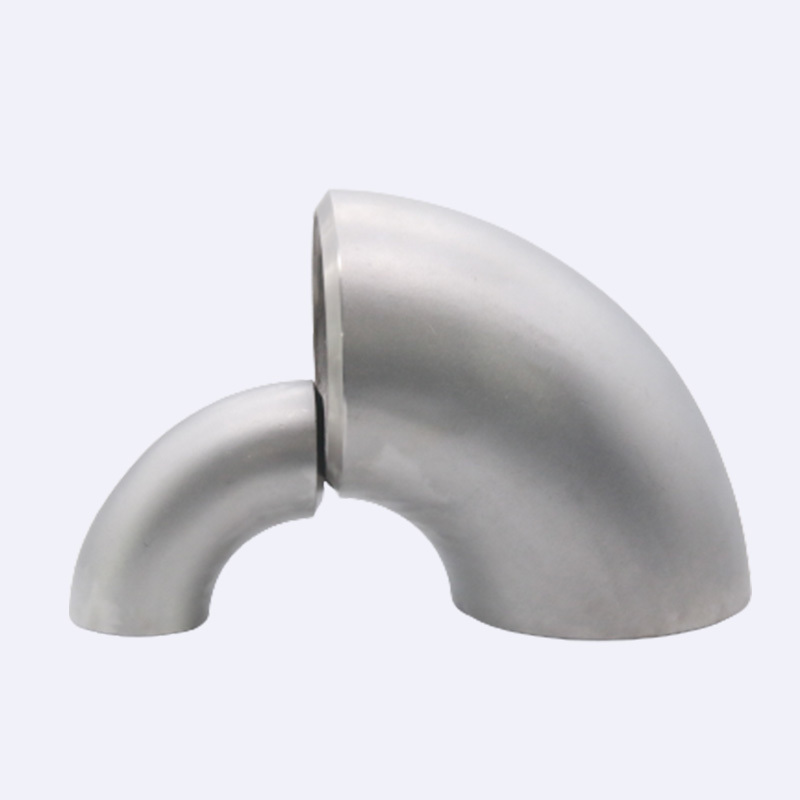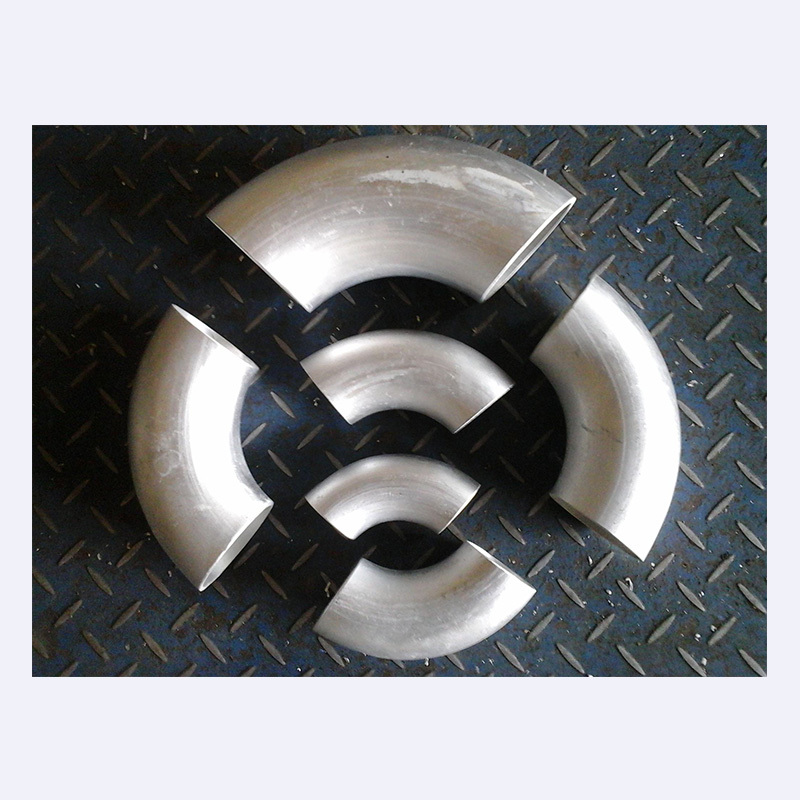Elbow
Key Word:
Category:
Products Detial
| Specifications | ASTM A234/ ASME SA234/ROCT10#/20#/Q235 |
| Dimension | ASME/ ANSI B16.9 | ASME B16.28 |JIS Standards |GOST Standards... |
| Thickness of Fitting | SCH 10, SCH20, SCH 30, STD SCH 40, SCH 60, XS, SCH80, SCH100, SCH 120, SCH 140, SCH160, XXS available with NACE MR 01-75 |
| Types | Seamless | Welded |
| Bending Radius | R= 1D, 1.5D, 2D, 3D, 6D ... |
| Size Range | Sesmless Pipe Fittings Size Range: 1/2"---24" DN15---DN600mm Welding Pipe Fittings Size Range: 1/2"---80" DN15---DN2000mm Thickness:2mm-60mm |
| Market of World | Russia,European,South America,Southeast Asia,South Africa,Middle East ... |
| Manufacturer of Range | Pipe Cap, Tees, Reducers, 45 degree Elbow, 90 degree Elbow,180 degree Elbow,Pipe Bend, Crosses, 90º Elbow,buttweld fittings customed |
Product description
Elbow product introduction:
In a piping system, a bend is a pipe fitting that changes the direction of the line. According to the Angle, there are 45° and 90°180° three most commonly used, in addition, according to the engineering needs also include 60° and other abnormal Angle elbow. Elbow materials are cast iron, stainless steel, alloy steel, malleable cast iron, carbon steel, non-ferrous metals and plastics. The connection modes with the pipe are: direct welding (the most common way) flange connection, hot melt connection, electric melt connection, thread connection and socket connection, etc. According to the production process can be divided into: welding elbow, stamping elbow, push elbow, casting elbow, butt welding elbow and so on. Other names: 90 degree bend, right Angle bend, etc.
Brief introduction of elbow:
Elbow is a common connection pipe fitting in the installation of water heating, used for the connection of the pipe bend, used to change the direction of the pipe.
Other names: 90° elbow, right Angle bend, love bend, stamping elbow, pressing elbow, mechanical elbow, welding elbow, etc.
Purpose: To connect two pipes with the same or different nominal diameters, so that the pipe can be turned 90°, 45°, 180° and various degrees.
Bending radius less than or equal to 1.5 times of pipe diameter belongs to the elbow, greater than 1.5 times of pipe diameter belongs to the bend.
Material classification of elbow:
Carbon steel: ASTM/ASME A234 WPB, WPC
Alloy: ASTM/ASME A234 WP 1-WP 12-WP 11-WP 22-WP 5-WP 91-WP911, 15Mo3 15CrMoV, 35CrMoV
Stainless Steel :ASTM/ASME A403 WP 304-304L-304H-304LN-304N
ASTM/ASME A403 WP 316-316L-316H-316LN-316N-316Ti
ASTM/ASME A403 WP 321-321H ASTM/ASME A403 WP 347-347H
Low temperature steel :ASTM/ASME A402 WPL3-WPL 6
High performance steel: ASTM/ASME A860 WPHY 42-46-52-60-65-70
Cast steel, alloy steel, stainless steel, copper, aluminum alloy, plastic, argon plating, PVC, PPR, RFPP(reinforced polypropylene), etc.
Manufacturing classification of elbow:
1. According to the production method, it can be divided into pushing, pressing, forging, casting, etc.
2. According to manufacturing standards, it can be divided into national standard, electrical standard, ship standard, chemical standard, water standard, American standard, German standard, Japanese standard, Russian standard, etc.
3. According to its radius of curvature, it can be divided into long radius elbow and short radius elbow. Long radius elbow refers to the outside diameter of the pipe whose radius of curvature is equal to 1.5 times, that is, R=1.5D; A short radius elbow is one whose radius of curvature is equal to the outside diameter of the pipe, i.e. R=1.0D. (D is the diameter of the bend and R is the radius of curvature).
4. According to the pressure grade, there are about 17 kinds of pipes, which are the same as the American pipe standards, including: Sch5s, Sch10s, Sch10, Sch20, Sch30, Sch40s, STD, Sch40, Sch60, Sch80s, XS; Sch80, SCH100, Sch120, Sch140, Sch160, XXS; The two most commonly used are STD and XS.
5. According to different shapes, it can be divided into: groove type elbow, sleeve type elbow, double bearing elbow, flange elbow, reducing elbow, idler elbow, internal and external teeth elbow, stamping elbow, pushing elbow, socket elbow, butt welding elbow, internal wire elbow, etc.
General classification of elbow:
Flex elbow clip sleeve elbow with side elbow quick load elbow with seat flange elbow 180° elbow double bearing elbow single bearing elbow socket reducer seamless butt welding elbow 90° elbow 45° combination three-way internal thread elbow stamping elbow push elbow high pressure wear resistant elbow mechanical elbow flange type elbow Grooved elbow stereoscopic elbow external thread elbow special thread elbow waterproof elbow
Manufacturing process of elbow:
Seamless elbow: The elbow is a pipe fitting used at the bend of the pipe. In all the pipe fittings used in the pipeline system, the proportion is the largest, about 80%. Usually, different forming processes are selected for elbows of different materials or wall thickness. Manufacturers commonly used seamless elbow forming processes include hot pushing, stamping, extrusion and so on.
Elbow hot push forming:
Hot push elbow forming process is a process of using special elbow pushing machine, core die and heating device, so that the blank on the mold moves forward under the push of the pushing machine, and is heated, expanded and bent in the movement. The deformation characteristic of hot pushing elbow is to determine the diameter of the tube billet according to the law of constant volume before and after plastic deformation of the metal material. The diameter of the tube billet is less than the diameter of the elbow. The deformation process of the blank is controlled by the core mold, so that the compressed metal flow in the inner arc can be compensated to other parts thinned by expanding the diameter, so as to obtain the elbow with uniform wall thickness.
Hot push elbow forming process has the characteristics of beautiful appearance, uniform wall thickness, continuous operation and suitable for mass production, so it has become the main forming method of carbon steel and alloy steel elbow, and is also used in the forming of some specifications of stainless steel elbow.
The heating method of forming process has medium frequency or high frequency induction heating (heating ring can be multiple or single ring), flame heating and reflector furnace heating, which heating method depends on the requirements of forming products and energy situation.
Elbow stamping forming:
Stamping forming elbow is the first forming process used in mass production of seamless elbow. It has been replaced by hot pushing or other forming processes in the production of common specifications of elbow, but in some specifications of elbow due to the production quantity is small, the wall thickness is too thick or too thin.
The product is still in use when there are special requirements. The stamping forming of the elbow is made of a tube blank equal to the outside diameter of the elbow, which is directly pressed by a press in the die.
Before stamping, the tube blank is placed on the lower die, and the inner core and end die are loaded into the tube blank. The upper die moves downward to press the tube blank, and the elbow is formed by the constraint of the outer die and the support of the inner die.
Compared with hot pushing process, the appearance quality of stamping is inferior to the former. The outer arc of the stamping elbow is in a tensile state when forming, and there is no excess metal in other parts to compensate, so the wall thickness of the outer arc is about 10% thinner. But because it is suitable for single piece production and low cost, the stamping elbow process is mainly used for the manufacture of small batch and thick wall elbow.
Stamping elbow is divided into cold stamping and hot stamping two types, usually according to the material properties and equipment capacity to choose cold stamping or hot stamping.
The forming process of cold extrusion elbow is to use a special elbow forming machine, put the tube blank into the outer die, the upper and lower die closing die, under the push rod, the tube blank along the inner die and the outer die reserved gap movement to complete the forming process.
The elbow made by internal and external die cold extrusion process has beautiful appearance, uniform wall thickness and small size deviation. Therefore, the stainless steel elbow, especially the thin-wall stainless steel elbow forming, is manufactured by this process. The internal and external die used in this process requires high precision; The wall thickness deviation of the tube billet is also strict.
Bend medium plate welding:
Make half of the bend section with a medium plate press, then weld the two sections together. This process is generally used for DN700 above the elbow.
Other forming methods of elbow:
In addition to the above three commonly used forming processes, seamless elbow forming also adopts the tube blank extrusion to the outer die, and then through the tube blank ball shaping process. However, this process is relatively complex, troublesome to operate, and the forming quality is not as good as the aforementioned process, so it is rarely used.
Scope of use of elbow:
Because the elbow has good comprehensive performance, so it is widely used in chemical industry, construction, water supply, drainage, petroleum, light and heavy industry, freezing, health, water heating, fire, power, aerospace, shipbuilding and other basic engineering.
Development prospect of elbow:
China is already the world's largest producer and consumer of building materials. The output of main building materials such as cement, plate glass, building sanitary ceramics, stone and wall materials has been ranked first in the world for many years. At the same time, the quality of building materials products continues to improve, the consumption of energy and raw materials decreases year by year, a variety of new building materials continue to emerge, building materials products continue to upgrade. Cangzhou pipeline equipment manufacturing industry has a thick foundation. Currently, there are more than 3,200 production enterprises, including 222 enterprises above designated scale (sales revenue of more than 5 million yuan), employing 124,000 people. The main products are a variety of special steel, stainless steel, carbon steel and other seamless steel pipes of various diameters, low, medium and high pressure boiler pipe, oil drilling pipe and other steel pipes; All kinds of three-way, four-way, valve, reducing pipe and other elbow fittings; All kinds of stainless steel flange, forged flange; All kinds of pipe racks, instruments, oil blowout preventer and other pipeline accessories; All kinds of polyethylene pipe, polypropylene pipe and other plastic pipe, a total of 16 categories of more than 370 varieties of 3500 kinds of specifications. The manufacturing process mainly adopts hot rolling straight seam welding, spiral double-sided submerged arc welding, forging, forging, medium frequency pushing, cold forming, hot extrusion, etc. The maximum processing diameter of pipeline is 2020mm. The products are widely used in municipal, petrochemical, west-east gas transmission, shipbuilding and nuclear power engineering fields, with an annual designed processing capacity of 25 million tons. In 2010, the industrial added value of enterprises above designated size reached 13 billion yuan, up 31.7% year on year, accounting for 16.1% of the total added value of enterprises above designated size. Cangzhou pipeline equipment manufacturing industry is moving forward to the goals of "three high" (scale, level and equipment) and "three high" (high-end, high pressure, high added value), and striving to promote the capacity of pipeline equipment manufacturing industry to reach 30 million tons. Cangzhou will become a well-known "pipeline equipment manufacturing and R&D base" and "pipeline equipment capital" at home and abroad. The "eleventh Five-Year Plan" infrastructure investment has reached the middle stage. The explosive growth of highway, railway and other infrastructure construction investment and the steady growth of ordinary civil construction investment make the construction industry in the booming stage. At the same time, under the background of building an energy-saving society and strengthening the capacity of independent innovation, the theme of energy conservation and technological innovation will be the development hotspot of the industry. Plastic pipe fittings and pipes are once again the pipe fittings craze.
Company Show

Related Products
Product Inruiry
Please fill in the form to get more information as soon as possible







